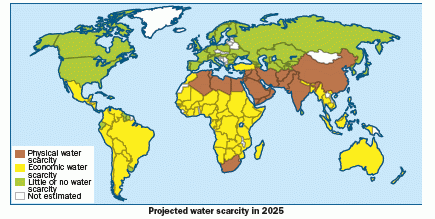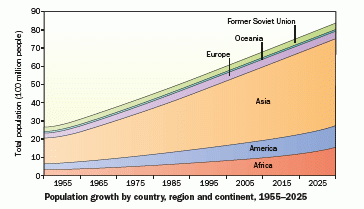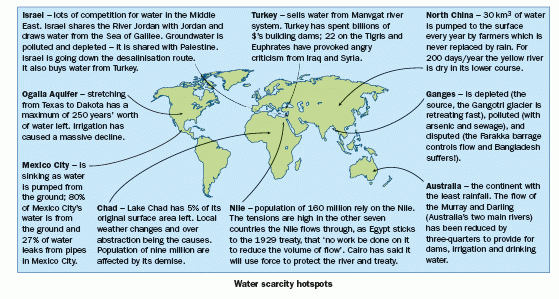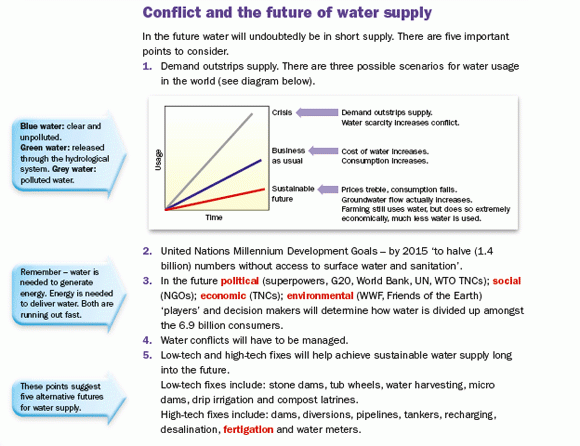Water Conflict
Water: demand and supply
The conflict over water relates to the gap between demand and supply. Add in climate change, the geopolitics of water transfers and pressures from population increase and the problem becomes only too obvious. By comparing the two diagrams below what should become obvious is that by 2025 the countries growing most rapidly will experience the very lowest water availability.

Global water consumption rose six times greater than population increase between 1990–95

Background
Only about 3% of the Earth’s water is potable (useful to drink or for agriculture and industry). Three factors determine supply.
- Climate is critical in determining water supply.
- Rivers move water around. But they experience seasonal flow and water balance variation; both factors determine water supply
- possibilities.
- Geology a country with little permeable rock (sedimentary chalks and sandstone for instance) will have no storage of groundwater.

Shortage, scarcity and stress (SSS)
Shortage - Shortages of water have become common place in many areas of the world – too many areas receive low levels of water supply relative to basic needs. Sahel, South America, China, India and Pakistan all experience SSS.
Case study: Sucking India dry - Water from rainfall is only available from surface supply from July to September in many parts of India. Competing demands for water causes scarcity. In Kishangarh, Rajasthan in India the operations in a marble factory is sucking the ground dry (over extracting water causing shortages of drinking water), but in the fields crops die through lack of water and people die through starvation.
Scarcity and stress
When water supply falls below 1000m3/year a huge imbalance between supply and demand can occur. The world is said to be ‘water bankrupt’ and that the water scarcity crisis is a bigger threat to the world than the financial crisis. Scarcity of water and hydrological shock (where suddenly there is no rain and no replenishing of groundwater and river water) brought on by climate change, will increase the
risk of major international and national security threats – the water wars.
Poor water quality increases disease. Stored water harbours mosquitoes – two-thirds of countries by 2025 will live in water stress.

Case study: Two stressed drainage basins
- The Tigris-Euphrates Basin - A situation with serious international implications is the demand for the waters of the Euphrates by Turkey, Syria and Iraq. The Euphrates is the primary water source for millions of people who depend on it for power generation and irrigation in an extremely arid climate. Conflict over water in this area is decades old. It has intensified in recent years as a result of a massive Turkish dam building programme known as the Greater Anatolia Project (GAP), designed to provide a supply of water and power adequate to fuel the development needs of Turkey’s population, which is growing at 1.6% annually. It provides Turkey with a generating capacity of 7500 MW of electricity, which is nearly four times the capacity of Hoover Dam, and will open up at least 1.5 million hectares of land to irrigated cultivation. Full implementation of the GAP system of dams could result in a 40% reduction of the Euphrates’ flow into Syria and an 80% reduction of flow into Iraq. This will reduce the electrical output of Syria’s Tabqa Dam by up to 12%, while Iraq could lose irrigation water to 1 million hectares. The levels of salinity will increase, as well as the amounts of agricultural and industrial pollution, in the remaining water. Syria and Iraq have already threatened war over their access to the Euphrates. As the populations of these nations continue to expand, driven by fertility rates well above the global average, the competition for fresh water between agriculture and development could endanger stability in the region.
- The Nile - In Egypt it has been recognised for some time that the headwaters of the Nile might be developed.Egypt has threatened war, to preserve its access to fresh water. Ethiopia has already built some 200 small dams on the Nile since emerging from civil war and famine.

